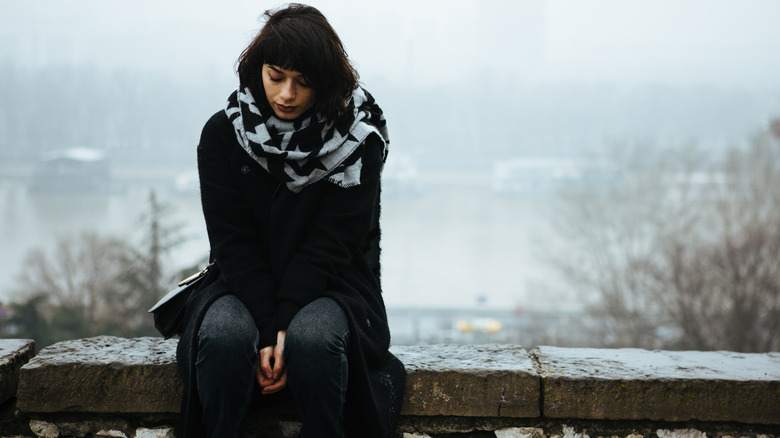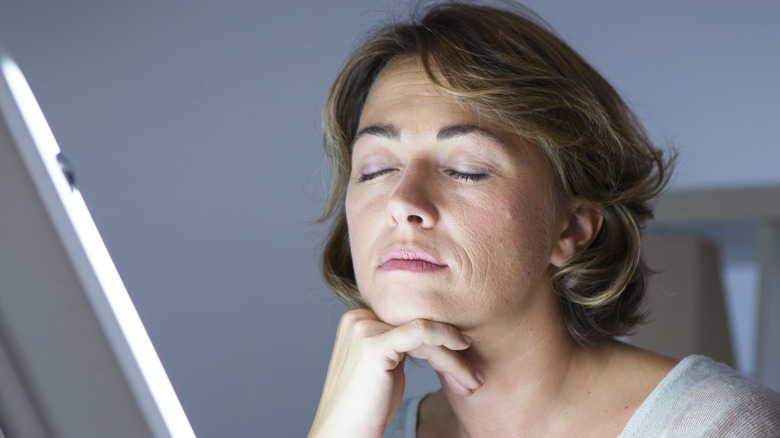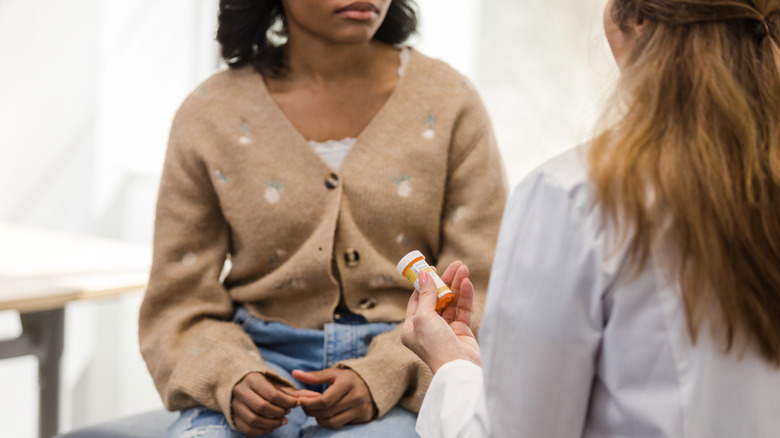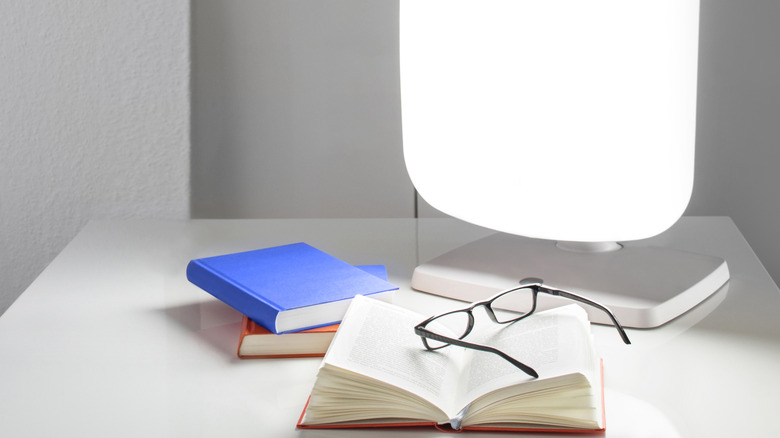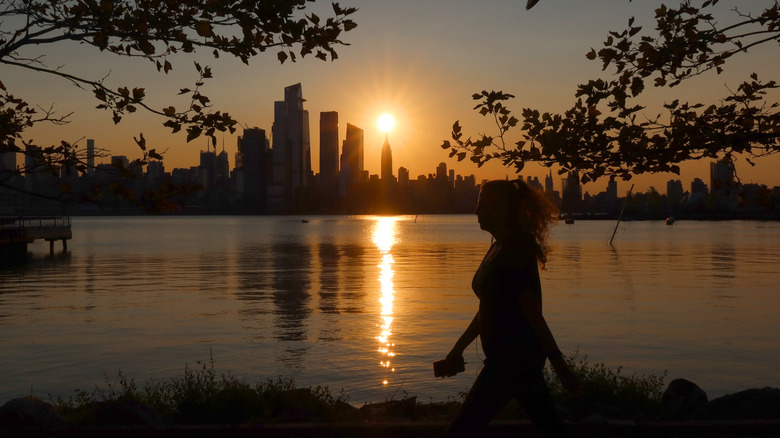Psychiatrist Tells Us If SAD Lamps Can Actually Do Anything For Your Mental Health
As much as the winter months can give us a nice break from the sweltering days of summer, they're not without their downsides. Even those who genuinely love the cold are likely to complain about the super short days and the grayness that outweighs the sun. Because sunlight is essential to human health, it's easy to feel out of sorts or even downright depressed in the winter. The American Psychiatric Association (APA) defines this type of depression as seasonal affective disorder (SAD) and it affects five percent of adults in the U.S. Depending on where someone lives, and how long they go without sunlight, SAD can last anywhere from four to five months of the year.
According to the National Institute of Mental Health, SAD's symptoms aren't unlike non-seasonal depression, consisting of hopelessness, irritability, and feelings of worthlessness, as well as difficulty sleeping, eating, and/or concentrating. SAD can even lead to suicidal ideation. "People may not appreciate how severely someone who has SAD is affected," psychiatrist at the Yale School of Medicine Dr. Paul Desan tells The New York Times adding, "their life just shuts down for half the year."
Although there are a few ways to treat SAD, light therapy has become one of the most common — even making the rounds on TikTok — as the go-to method to boost one's mood. And with that, there's been a rise in light therapy lamps. Available in shapes that range from tiny bedside spheres to giant boxes, and prices that range from as little as $20 to $300, these specialty lamps work by emitting an ultra bright light that mimics the sunlight we're missing. But can a special SAD lamp really get you through the winter? In an exclusive chat with Women, board-certified psychiatrist, brain health specialist, and 12-time New York Times bestselling author Daniel Amen, MD gave us his take on these lamps.
A light therapy lamp could improve your mood
"People with seasonal affective disorder (SAD) tend to have trouble regulating the "feel-good" neurotransmitter serotonin, which research shows is involved in mood control," Dr. Amen exclusively tells Women. "Bright light therapy lamps, also called SAD lamps, have been found to increase serotonin levels and promote more positive moods." In fact, one study determined that two hours of daily light therapy could improve one's mood within a couple weeks.Another study found that individuals with seasonal depression experienced an immediate positive change in their moods after just one 20 minute light therapy session.
Because of the relief that light therapy offers, some doctors recommend it to treat non-seasonal depression, too. "For both seasonal and nonseasonal depression, the effectiveness of light therapy is approximately the same as antidepressant medications, or popular forms of psychotherapy such as cognitive behavioral therapy," associate professor of psychiatry at Harvard Medical School Dr. Richard S. Schwartz tells Harvard Health Publishing. Dr. Amen adds that bright light therapy could help "improve energy levels, focus, and sleep."
It could be an alternative to taking SSRIs
Although light therapy itself is not a cure for depression, many doctors still find that consistent use can help manage SAD symptoms, like insomnia. Dr. Amen tells Women that some research has suggested that bright light therapy may be as effective as some oral antidepressants. Indeed, per a 2017 study published in Einstein Journal of Biology and Medicine, light therapy has been found to be so efficient at managing and treating SAD, that some doctors actually recommend it before anything else.
The other draw with using light therapy is that it doesn't come with the side effects that SSSRIs have, such as weight gain and sexual dysfunction, Dr. Amen tells Women. "I often recommend bright light therapy lamps to my patients at Amen Clinics who have SAD, because it offers benefits without the unwanted side effects associated with antidepressants," he says.
However, for people who are really struggling to keep their mental health in check during the winter months, it seems that a combination of the light therapy and medication is what really does it. According to a 2018 study published in Sleep Medicine Reviews, one clinical trial found that the participants who received both light therapy and antidepressant drugs experienced a lower depression score than each method administered solo or combined with placebo.
How to choose a SAD lamp
If you've decided to give light therapy a try, it's important to keep in mind that not just any lamp will do. You need one that specifically mimics sunlight so as to experience the necessary benefits on your brain, body, and circadian rhythms. Although you don't necessarily need to jump on buying the super expensive, trendy lamps, Mayo Clinic recommends purchasing a SAD lamp that has a minimum light exposure rating of 10,000 lux. Dr. Amen adds, that for best results, your SAD lamp should have "full-spectrum light" and be used "for 20-30 minutes each morning during the winter months."
Mayo Clinic recommends sitting about 16 to 24 inches from the lamp with your eyes open, but averted from the light — some lamps come for eye protection for this very reason. When choosing the location for it in your home, put it in a place where it will get the most use like next to your bed or couch, or in your bathroom next to the mirror as part of your morning routine.
Other ways to manage SAD
Of course, while light therapy may be a good option for some, it's important to keep in mind that it's not the only avenue for dealing with seasonal depression, and it may not be enough on its own. "Other strategies to combat seasonal affective disorder are similar to those used to manage [non-seasonal] depression," Dr. Amen, MD exclusively tells Women, adding that monitoring Vitamin D levels, also known as the "sunshine vitamin" is key. "This is important because vitamin D is believed to be involved in serotonin activity."
Amen adds that eating a healthy diet is also important, no matter where you live. "During the darker months, people with SAD often crave carbohydrates and have a tendency to overeat," said Amen. "Resisting those urges to overindulge in high-glycemic carbs can be helpful." While research has proven that eating carbs can make us feel better in the moment, their effect on the body's blood sugar levels can cause mood changes that contribute to feelings of depression. "Choose complex carbs like sweet potatoes or quinoa instead and eat serotonin-rich foods like eggs, turkey, nuts, and seeds," said Amen. Another technique according to Amen, is to "kill the ANTs (automatic negative thoughts). "Learning to challenge the negative thoughts that pop into your head can be so helpful in flipping the switch on your moods no matter what time of year it is."
If you or someone you know is struggling or in crisis, help is available. Call or text 988 or chat 988lifeline.org
